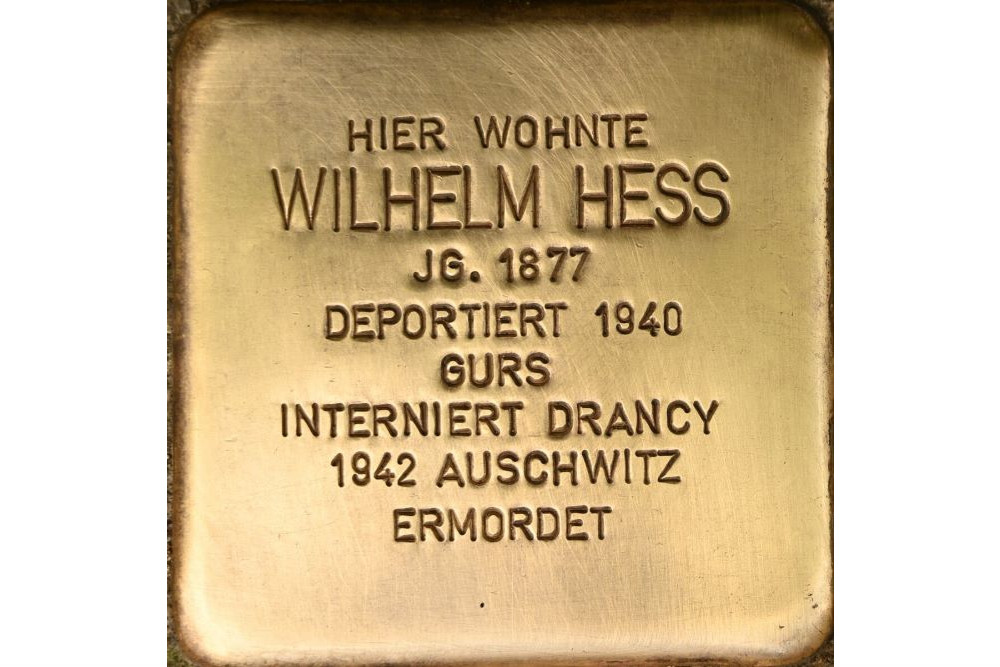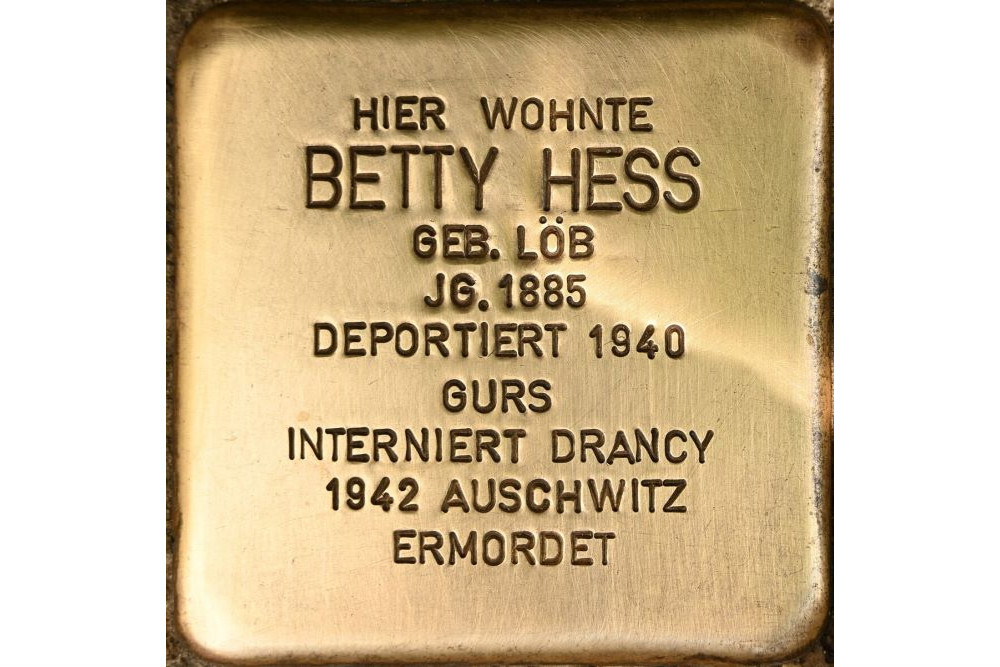Stumbling Stones Hauptstrasse 86
These small brass memorial plaques (Stolpersteine or stumbling stones) commemorate:
* Wilhelm Hess, born 1877, deported 1940 Gurs, interned Drancy, 1942 Auschwitz, murdered.
* Betty Hess née Löb, born 1885, deported 1940 Gurs, interned Drancy, 1942 Auschwitz, murdered.
* Simon Eugen Hess, born 1912, fled 1939, Brazil.
* Käthe Hess, born 1913, fled 1938, USA.
* Helmut Hess, born 1915, fled 1939, Brazil.
* Hilda Hess, born 1918, fled 1939, England.
Background
Wilhelm Hess was the son of Samuel Simon Hess (1842-1932) and Therese Kaufmann Hess (1848-1940). A stolperstein for Therese is nearby, at Letzenbergstraße 5.
In 1900, Wilhelm Hess joined his father in a business, "Samuel Hess and Son Partnership." Wilhelm probably bought the house at Hauptstraße 86 just beforehis 1910 marriage to Betty Löb, the daughter of a master baker. The house had two stories and a barn that eventually held 15 cattle and horses. The couple also owned fields for grazing and growing animal feed. Wilhelm and Betty had four children – Simon Eugen (1912), Käthe (1913), Helmut (1915), and Hilda (1918).
In 1921, Samuel Hess retired and turned the business over to son Wilhelm. In the 1930s, the business was seriously affected by Nazi actions, starting with customers not paying for goods (as Hitler had advised). By 1937, the trading license had been withdrawn. The family survived on their what they could grow plus on the milk from one remaining cow. On Pogromnacht in November 1938, the house was attacked and most of its contents destroyed.
The four adult children all left Germany – likely with assistance from their parents. Simon Eugen was taken to Dachau for several weeks after Progromnacht, but Helmut was spared that experience. Both brothers then left Germany in 1939 for Bolivia, and then both settled in Brazil. The two sisters were employed as domestic workers in various locations in Germany but then could find no work: Aryans would not employ them, and Jewish families could no longer afford staff. Käthe emigrated to New York in April 1938, married and had 2 children, Michael and Betty Hornik. Hilda went to England in 1939, married Emanuel Katz who had emigrated there from Vienna; they had one child, Peter Katz, who came to Malsch for the 23 May 2023 installation of the stolpersteine for his relatives.
Wilhelm and Betty Hess were deported to the Gurs internment camp on 22 October 1940. In 1942, the Vichy officials began emptying Gurs, turning over Jewish prisoners to the Nazis. Wilhelm and Betty were among the first to be deported from Gurs to Drancy and then, 6 days later they arrived in Auschwitz on 12 August 1942. They were murdered that same day.
"Stolpersteine" is an art project for Europe by Gunter Demnig to commemorate victims of National Socialism (Nazism). Stolpersteine (stumbling stones) are small, 10x10cm brass plaques placed in the pavement in front of the last voluntary residence of (mostly Jewish) victims who were murdered by the Nazis. Each plaque is engraved victim’s with the name, year of birth, and place (mostly a concentration camp) and date of death. By doing this, Gunter Demnig gives an individual memorial to each victim. One stone, one name, one person. He cites the Talmud: "A human being is forgotten only when his or her name is forgotten."
Do you have more information about this location? Inform us!
Source
- Text: Anne Palmer
- Photos: Christian Michelides (1), Christian Michelides (2)
- Malsch Stolperstein Booklet 2023, a PDF file; pp. 18-27.
- Holocaust Encyclopedia: Gurs
- Stolpersteine.eu
Nearby
Point of interest
Monument
- Memorial Jewish Cemetery Bad Schönborn - Bad Schönborn
- War Memorial Bad Langenbrücken - Bad Langenbrücken
- Memorial Forced Resettlement 1944-1945 - Bad Langenbrücken
Cemetery
- German War Graves Bad Langenbrücken - Bad Langenbrücken
- Wargraves Wiesloch - Wiesloch
- Graves Victims National Socialism Neuenbürg - Neuenbürg





